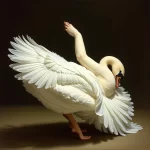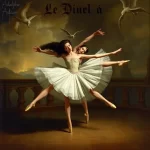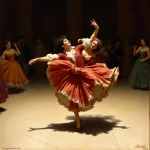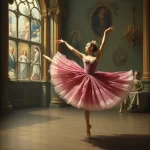Ballet: The Dying Swan (Camille Saint-Saëns, 1905)

Introduction
Ballet, an art form that combines music, dance, and storytelling, has produced numerous iconic pieces over the centuries. One such masterpiece is “The Dying Swan,” choreographed by Mikhail Fokine to the music of Camille Saint-Saëns. Premiered in 1905, this short but powerful ballet has captivated audiences with its emotional depth and technical brilliance. The ballet’s theme revolves around the final moments of a swan’s life, symbolizing beauty, grace, and the inevitability of death.
Historical Background
Creation and Development
“The Dying Swan” was created during a period of significant transformation in the world of ballet. The early 20th century saw a shift from the grand, narrative ballets of the Romantic era to more abstract and expressive forms. Mikhail Fokine, a pioneering choreographer, sought to break away from the rigid conventions of classical ballet. He was inspired by the expressive potential of dance and aimed to create works that conveyed deep emotional and psychological themes.
The inspiration for “The Dying Swan” came from a poem by Alfred, Lord Tennyson, titled “The Dying Swan.” Fokine envisioned a solo piece that would capture the swan’s final moments, blending technical prowess with profound emotion. Camille Saint-Saëns’ composition “Le Cygne” from “The Carnival of the Animals” provided the perfect musical backdrop for this vision. The collaboration between Fokine and Saint-Saëns resulted in a ballet that was both innovative and deeply moving.
Premiere and Reception
“The Dying Swan” premiered on December 22, 1905, at the Mariinsky Theatre in Saint Petersburg, Russia. The role of the swan was performed by the legendary ballerina Anna Pavlova, whose interpretation of the character became iconic. The initial reception was overwhelmingly positive, with critics and audiences alike praising the ballet’s emotional intensity and Pavlova’s exquisite performance.
Notable early performances included Pavlova’s tours across Europe and the United States, where she introduced “The Dying Swan” to international audiences. The ballet quickly became a staple in her repertoire, and its popularity continued to grow with each performance.
Synopsis of the Ballet
“The Dying Swan” is a one-act ballet that lasts approximately four minutes. Despite its brevity, the ballet is rich in emotional content and technical complexity.
Detailed Summary
The ballet opens with the swan gliding gracefully across the stage, its movements fluid and ethereal. As the music progresses, the swan’s movements become more labored, reflecting its struggle against the inevitability of death. The choreography captures the swan’s final moments with a series of delicate, fluttering movements, culminating in a poignant collapse. The ballet ends with the swan lying still, its life extinguished but its beauty immortalized.
Musical Composition
Composer’s Role
Camille Saint-Saëns, a renowned French composer, played a crucial role in the creation of “The Dying Swan.” His composition “Le Cygne” (The Swan) from “The Carnival of the Animals” provided the musical foundation for the ballet. Saint-Saëns’ piece is characterized by its lyrical melody and gentle, flowing rhythm, which perfectly complement the swan’s graceful movements.
Musical Themes and Motifs
The music of “Le Cygne” features a recurring theme that evokes the serene and melancholic nature of the swan. The cello, accompanied by the piano, plays a hauntingly beautiful melody that mirrors the swan’s elegance and fragility. This musical motif enhances the emotional impact of the ballet, drawing the audience into the swan’s final moments.
Famous Recordings and Performances
Over the years, “Le Cygne” has been recorded by numerous renowned cellists, including Yo-Yo Ma and Jacqueline du Pré. These recordings have helped to popularize the piece and bring its emotional depth to a wider audience. Additionally, many ballet companies around the world have performed “The Dying Swan,” each bringing their unique interpretation to the choreography and music.
Choreography and Dance
Choreographer’s Vision
Mikhail Fokine’s vision for “The Dying Swan” was to create a ballet that transcended traditional storytelling and focused on pure expression. He sought to capture the essence of the swan’s final moments through a combination of technical precision and emotional depth. Fokine’s choreography is characterized by its fluidity and subtlety, with each movement carefully crafted to convey the swan’s struggle and eventual surrender.
Signature Dance Numbers
The ballet’s most iconic dance number is the solo performance of the swan. This piece is renowned for its technical demands, requiring the dancer to execute a series of intricate movements with grace and precision. Key moments include the swan’s fluttering wings, delicate arabesques, and the final, heart-wrenching collapse. Each movement is designed to evoke the swan’s beauty and vulnerability, making it one of the most emotionally charged solos in ballet.
Notable Interpretations
Over the years, “The Dying Swan” has been interpreted by numerous dancers and choreographers, each bringing their unique perspective to the piece. Notable interpretations include those by Maya Plisetskaya, who infused the role with her own dramatic flair, and Uliana Lopatkina, whose performance was praised for its ethereal quality. Contemporary productions have also experimented with different styles and settings, demonstrating the ballet’s enduring relevance and adaptability.
Characters and Roles
Main Characters
The central character in “The Dying Swan” is, of course, the swan itself. This role is typically performed by a solo ballerina, who must convey the swan’s grace, beauty, and tragic fate through her movements. The swan’s character is both a symbol of natural elegance and a poignant reminder of life’s fragility.
Supporting Characters
As a solo piece, “The Dying Swan” does not feature any supporting characters. The focus is entirely on the swan and its final moments, allowing the audience to fully immerse themselves in the emotional journey of the character.
Famous Dancers
Many renowned ballerinas have portrayed the swan in “The Dying Swan,” each leaving their mark on the role. Anna Pavlova’s original performance set the standard for future interpretations, while dancers like Maya Plisetskaya, Uliana Lopatkina, and Svetlana Zakharova have brought their own unique qualities to the character. These performances have contributed to the ballet’s enduring legacy and continued popularity.
Cultural and Artistic Impact
Influence on Ballet and Dance
“The Dying Swan” has had a profound influence on the world of ballet and dance. Its emphasis on emotional expression and technical precision has inspired countless choreographers and dancers. The ballet’s success also helped to solidify Mikhail Fokine’s reputation as a pioneering choreographer and contributed to the evolution of ballet as an art form.
Cultural Significance
Beyond the world of dance, “The Dying Swan” has made its mark on popular culture. The ballet has been referenced in literature, film, and other media, often as a symbol of beauty and tragedy. Its themes of life and death resonate with audiences across different cultures and time periods, making it a timeless piece of art.
Legacy and Revivals
“The Dying Swan” continues to be performed and celebrated today, with major revivals and reinterpretations keeping the ballet alive for new generations. Modern adaptations have explored different styles and settings, demonstrating the ballet’s versatility and enduring appeal. The piece remains a staple in the repertoires of many ballet companies around the world, ensuring its legacy for years to come.
Iconic Productions
Historic Productions
One of the most famous historical productions of “The Dying Swan” was Anna Pavlova’s performance at the Mariinsky Theatre in 1905. Pavlova’s interpretation of the swan became legendary, and her tours across Europe and the United States helped to popularize the ballet internationally. Other notable historical productions include performances by Maya Plisetskaya and Galina Ulanova, both of whom brought their unique styles to the role.
Contemporary Productions
Recent productions of “The Dying Swan” have explored new interpretations and settings, reflecting the ballet’s enduring relevance. Contemporary dancers like Uliana Lopatkina and Svetlana Zakharova have brought their own perspectives to the role, while modern choreographers have experimented with different styles and techniques. These contemporary productions demonstrate the ballet’s adaptability and continued appeal to audiences today.
Production Design
The production design of “The Dying Swan” is typically minimalistic, focusing on the dancer’s movements and the emotional impact of the performance. Costumes often feature a simple white tutu, symbolizing the swan’s purity and grace. Lighting design plays a crucial role in creating the ballet’s ethereal atmosphere, with soft, diffused lighting enhancing the swan’s delicate movements.
Critical Reception and Reviews
Initial Critical Response
At the time of its premiere, “The Dying Swan” received widespread acclaim from critics and audiences alike. Reviewers praised the ballet’s emotional depth and technical brilliance, with particular emphasis on Anna Pavlova’s performance. The ballet was seen as a groundbreaking work that pushed the boundaries of traditional ballet and showcased the expressive potential of dance.
Modern Reviews
Contemporary critics continue to hold “The Dying Swan” in high regard, often highlighting its timeless themes and emotional impact. Modern reviews frequently praise the ballet’s ability to convey profound emotions through minimalistic choreography and music. The piece remains a favorite among audiences, who are drawn to its beauty and poignancy.
Fun Facts and Trivia
Behind-the-Scenes Stories
One interesting anecdote from the creation of “The Dying Swan” involves Anna Pavlova’s dedication to perfecting her performance. It is said that Pavlova spent hours observing swans in nature, studying their movements and behavior to accurately portray the character. Her commitment to authenticity contributed to the ballet’s success and her enduring legacy as a dancer.
Notable Performers
In addition to Anna Pavlova, many other famous dancers have left their mark on “The Dying Swan.” Maya Plisetskaya, known for her dramatic flair, brought a unique intensity to the role. Uliana Lopatkina’s ethereal performance was praised for its grace and subtlety. These dancers, among others, have helped to keep the ballet alive and relevant for new generations.
Trivia
- “The Dying Swan” is often mistakenly referred to as “The Swan,” but its correct title emphasizes the swan’s final moments.
- The ballet’s music, “Le Cygne,” is one of the few pieces from “The Carnival of the Animals” that Saint-Saëns allowed to be published during his lifetime.
- Anna Pavlova’s performance of “The Dying Swan” was so iconic that she continued to perform it until her death in 1931.
Conclusion
Summary of the Ballet’s Importance
“The Dying Swan” holds a significant place in the world of ballet, both for its artistic innovation and emotional impact. The collaboration between Mikhail Fokine and Camille Saint-Saëns resulted in a piece that transcends traditional storytelling and focuses on pure expression. The ballet’s themes of beauty, grace, and mortality continue to resonate with audiences, making it a timeless masterpiece.
Final Thoughts
Reflecting on “The Dying Swan,” it is clear why this ballet has endured for over a century. Its combination of technical brilliance and emotional depth creates a powerful experience for both performers and audiences. Whether you are a seasoned ballet enthusiast or new to the art form, “The Dying Swan” is a must-see performance that captures the essence of what makes ballet so captivating.
FAQ
What is the central theme of this ballet?
The central theme of “The Dying Swan” is the final moments of a swan’s life, symbolizing beauty, grace, and the inevitability of death.
Who are the main characters in this ballet?
The main character in “The Dying Swan” is the swan itself, typically performed by a solo ballerina.
What is the most famous dance number in this ballet?
The most famous dance number in “The Dying Swan” is the solo performance of the swan, known for its technical demands and emotional depth.
How long does a typical performance of this ballet last?
A typical performance of “The Dying Swan” lasts approximately four minutes.
Are there any modern adaptations of this ballet?
Yes, there have been numerous modern adaptations of “The Dying Swan,” with contemporary dancers and choreographers bringing their unique interpretations to the piece.
Why is this ballet considered important in the history of dance?
“The Dying Swan” is considered important in the history of dance for its innovative choreography, emotional depth, and lasting impact on the world of ballet. It helped to pave the way for more expressive and abstract forms of dance, influencing generations of choreographers and dancers.





